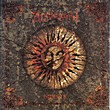|
|

From head to heart Following our retroscope series of latter years, here we go again! Here's Speakers' corner's cousin; From head to heart. Luna Kafé's focused eye on great events, fantastic happenings, absolute milestones, or other curious incidents from the historic shelves'n'vaults of pop'n'rock. Blowing our ears and our head, punching our chest and shaking our heart. Making us go sentimental, but not slaphappy. This moonth the Lunar retro-jukebox rewinds 20 years. We're talking Swedish prog, midway between now and then: on the halfway of the golden era of the early 70s, and todays neo-prog scene. 1993 was way back when Grunge andime Britpop had most of the headlines. This is a release from the back-alleys of rock at the time. Or, maybe, out of time. However, the band must not be confused with the cheesy Swedish feel-good film from 1992.
Änglagård I'm not quite sure when this album was released. If you search the net, you'll probably find 'late 1992' as the most exact. However, the Swedish library authority says 1993 with a question mark afterwards. I've checked with Jørn Andersen who released the LP-version on his Colours label, and he states that it didn't see the light of day until sometime early in 1993. If you have a chance to take a good look at the mirror of the LP, it has engraved the date 16. december 1992. After that the vinyl was pressed and that neccessarily needed some time to be finished. Anyhow, the album marks a nice early peak of the new wave of Swedish progressive rock, and a great collaboration across the border to Norway. Landberk and Fafner started the ball, approached the Norwegian Colours label. Colours had a good reputation in progressive circles and it resulted in LP-releases by the two bands in 1992. Änglagård followed suit while the CD version of Hybris was handled by Swedish Mellotronen Records. Landberk and Änglagård, along with Anekdoten a little later, was a breath of fresh air in the early 1990s Swedish scene, with a breed that crossed early 1970s Swedish and British progressive rock and folk elements along with enough personal and up to date touches to make this very nice and tasteful. And it seems to have marked the start of a new wave of progressive rock internationally, too. While early Landberk and Anekdoten draws on King Crimson's melodic and metallic moods respectively, Hybris seems more inspired by Genesis and Gentle Giant to name but two early sources. Some also mention American Cathedral's only album Stained Glass Stories from 1978 as a major influence (I haven't heard it). But there is a lot more going on here to keep the interest. The band was formed in 1991 and the first half of the following year, before the recordings of the album started, was spent to develop the tunes by all six members. The music is built on conflict, the band members state: 'Personal feelings and the impulsivness have been the hardest adversary in our struggle to put the tunes together. We don't seek a well balanced or predictable entirety. This pot is cooked by six fantastic cooks, each one a victim of hybris.' This is true. The music is mainly instrumental, filled with majestic Mellotron, sombre and lyrical flutes, Genesis sounding Hammond, guitars pulling in each and every direction and bass and drums to keep it all together. Btw. drummer Mattias Olsson (later of Pineforest Crunch) was only 17 when the album was recorded. The music can be calm and folk-inspired, maybe with a touch of for instance Kebnekajse or Älgarnas Trädgård from the early 1970s that also made use of the Swedish folk heritage. But it doesn't last long. Around the next corner the tempo might change dramatically. Less melodic guitars and mellotron might pull jazz or experimental linings, followed by a close to symphonic passage. If you like your music to build slowly to get you in the mood, Änglagård is surely not for you. If you enjoy a soup that bubbles and seethes with youthful enthusiasm, there is no need to look any further. If there is a problem with Hybris, it has to be too many ideas crammed into one album. Others will say it's a strength. Highlights include the sincere and folky vocal part of "Från Klarhet Till Klarhet" and the first ditto of "Kung Bore", the mellow flute followed by pompous church organ-sounding middle part and then on to a Genesis-sounding interlude a little later before that Swedish folk flute returns of "Jordrök", the cutting guitar passages before the melodies sweetens on some of the tracks, the quiet acoustic guitar intro before the rest of the band with flute, electric guitar and organ in front takes over of "Från Klarhet Till Klarhet" ... to name but a few. Änglagård managed to record one more studio album, the all instrumental Epilog, and a live one before the band folded. At least the latter was not released until the band was history. The gang returned for some 2003 gigs, but without the man who started it all, guitarist Tord Lindman, and then a second reunion in 2009. Last autumn saw the release of Änglagårds third studio album, Viljans Öga, once again without Tord. A bit more reflective and less crammed compared to Hybris, I guess, but then no-one can quite match that folly of youth. Copyright © 2013 JP
|
| © 2013 Luna Kafé |
